I remember the moment like a heartbeat: heavy monsoon clouds gathering over the forest path leading to Angkor Wat. The humidity pressed on our skin, and the thick leaves above rustled with anticipation of rain. I was walking with my close friend and her little daughter—a curious, bright-eyed four-year-old named Mira. She had been running ahead, chasing a golden dragonfly dancing between shafts of light. Suddenly, I heard her cry—sharp, urgent, terrifying in its innocence.
Why cry, my baby? I thought. My friend scooped her up immediately, shielding her small head under her arm. Few seconds mattered an eternity.
My friend—soft but strong—looked into Mira’s tear-streaked face. She brushed wet hair from the child’s forehead, and asked gently, “What’s wrong with you, love?” Her voice was calm, steady, the kind that a mother unconsciously uses when she knows time can pause.

The moment hovers in my memory—the ancient stones of Angkor behind us, the forest around breathing and waiting. I realized I was more than a witness; I was absorbing a story that would linger.
Mira’s tears came in waves. At first, she couldn’t speak—just gasps of upset. My friend held her close. I knelt and offered a small hand to hold. The air smelled of wet earth and moss, with incense drifting from a temple not far. The setting felt sacred—as though the guardians of Angkor Wat forest themselves leaned in to listen.
“I… I fell,” Mira whispered, voice trembling. She pointed to her small knee, where blood welled beneath dirt. A little scratch, but for her young world, it might as well have been a mountain injury. My friend gently cleaned the wound with water from a small bottle, humming a lullaby under her breath. I helped with a tissue.
In that moment, I felt transported—not only by the physical surroundings of tall sandstone towers and wild roots, but by the emotional landscape unfolding in front of me. A child’s cry, a parent’s quiet power, the forest and temple around as silent witnesses.
I could imagine an older, deeper echo: centuries ago, perhaps, a child had cried in similar surroundings—lost, hurt, scared. Yet the ancient stones had endured, the forest regrown. Healing was possible.
Why cry, my baby?—this simple question unlocked the moment. It acknowledged that tears were allowed, that pain mattered. And then What’s wrong with you?—not in a blaming tone, but in search of truth and comfort.
Once the wound was cleaned and a small bandage applied (adorned with cartoon elephants that made Mira giggle), the tears began to slow. My friend continued to cradle her daughter, brushing damp hair from her face and offering water and a snack. The shift was gentle: from acute pain and fear to tenderness and relief.
I asked if I could tell the story from my perspective, and my friend nodded. I realized I wanted to commit it to memory: to capture how empathy in a sacred, natural setting can transform a frightened cry into healing. The Angkor Wat forest served as more than backdrop—it was a silent participant: the shade cooled our skin, the ancient trees offered shelter, and the distant temple bells or chants (if any) felt like a rhythm grounding us.
As evening approached, the sky opened in a light rain. We sheltered beneath broad leaves and watched droplets ripple on muddy puddles. Mira, now calmer, pressed her small hand into mine and whispered: “Thank you.”
My friend smiled through relief and fatigue. I realized that the question—Why cry, my baby? What’s wrong with you?—had done more than open a line of communication. It had validated emotion, invited trust, and allowed healing. And the forest and temple around us had responded with sacred stillness.